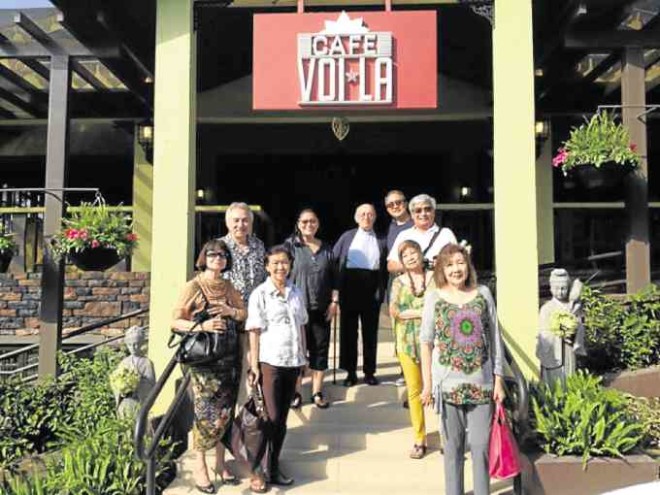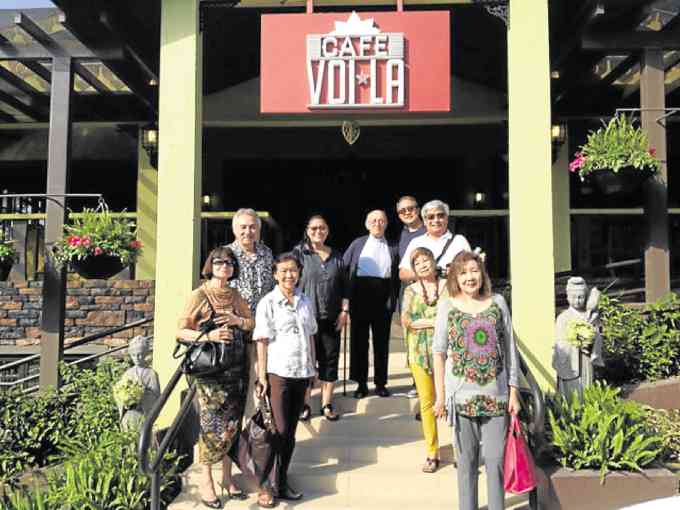
and Cynthia Picazo; back row: Carlitos Buendia, Voi-la proprietor Ica Sebastian, Fr. Javier de Pedro,
Grancis Sebastian and Arps de Vera
Blanche David-Gallardo’s “The Expat Kitchen,” published and distributed by Anvil Publishing Inc., is an extensive collection of recipes from around the region and beyond.
It is, as described in the title, “a cookbook for the Global Pinoy.”
Here, in her own words, is a glimpse at the contents of the book, as excerpted by the author herself:
“It must be the gypsy in my soul, the Pampango in my blood, but who’d have thought, when I was a young bride mincing garlic and chopping onions as a living ‘kitchen aide’ to my then more kitchen-savvy husband (who did the cooking for us), that I would one day learn to cook, let alone write a cookbook!
“Not that I was disinterested in food, or cooking. As a teenager I enjoyed whipping up desserts. But my one attempt at cooking was a dismal failure, a fiasco that left me mortified. I had invited my then boyfriend (later, husband) to breakfast, planning to serve potato omelette. I diced the potatoes as I had seen done countless times. But how was I to know they were meant to be pre-cooked before being folded into the beaten eggs in the frying pan?
“I might never have lived down the occasion were it not for the events that followed which brought us to Hong Kong, and me, to a comfortable familiarity with home cooking and recipes from virtually around the world.
“At the onset of the sixties, plans for the first-ever regional Sunday supplement—The Asia Magazine—came to be implemented, and recruitment began in earnest for editorial, advertising, marketing and support staff. From east and west, north and south, in the winter of 1961, they streamed into the then British crown colony. Recruited by Frankie Sionil José (National Artist for Literature, who served as the first editor), and signed on in Manila by the would-be publisher Adrian Zecha (better known today for his other and immensely more successful brainchild—Aman Resorts, the very exclusive high-end getaways for the rich and famous), my husband and I flew to Hong Kong in mid-February that year on a prop-jet Philippine Airlines flight which probably took more than four hours to traverse the distance.
“My earliest mentors on Chinese food and cuisine were The Asia Magazine president Norman Soong and his wife Delia. Norman was a raconteur and consummate gourmet with a phenomenal knowledge of Chinese food and history in all its regional nuances. And Delia was a gifted cook and elegant hostess in whose kitchen I learned some of the basic techniques and secrets of Chinese cooking.
“A meal with the Soongs— whether at their home, or some fine restaurant—was always special, not just for the feasts they invariably were for the eyes and the palette, but as learning experiences, where tidbits of information invariably peppered the food.
“As The Asia Magazine Women’s Editor, my job was to produce the four different departments (or sections) that went into the weekly women’s pages, namely: Fashion, Homes, Shopping and yes—
Food! Those were very early days of magazine publishing in Asia, and I was the ‘one-foot-kick’ (all around) functionary. I did not just work on assigned topics, I also did just about everything else connected to the job, except photography and page layouts.
“I was my own wardrobe mistress, make-up artist, hair stylist and fashion director rolled into one for fashion shoots involving —in those days—unpaid amateur models from the ranks, oftentimes, of high society.
“Shopping sprees were an occupational hazard each time I did my swing around Asia sourcing for new and exciting products to feature.
“Interviews with interior designers and architects left me with an abiding interest in interior design and architecture. At home, my kitchen became the lab where recipes scheduled for publication were tested and photographed. Being the quintessential novice, I maintained with some justification, that if I couldn’t follow a recipe, nobody else could.
“While Chinese food was somewhat familiar territory to me, being Filipino, my acquaintance with the other major cuisines of Asia, particularly from the Indian subcontinent, was virtually nil. Good friends and colleagues from India and Sri Lanka, plus a two-year stay in Singapore where the magazine moved at the height of the Red Guard disturbances in Hong Kong, soon took care of that. My growing interest in—and taste for—the spicy and aromatic cuisines of India, Indonesia, Thailand, Vietnam, Singapore, etc., date to those days.
“But more than the professional cook, cookbook writer, or celebrity chef I met in the course of my work, it was/is the creative home cook of every race, color, nationality and culinary persuasion—blessed with the talent for adapting, adopting, substituting, modifying and personalizing food and its creative presentation—who has influenced me the most.
“For this reason, I have chosen ‘The Expat Kitchen’ as the title and content of this volume.
“In his book, ‘Manila, My Manila,’ the late National Artist for Literature Nick Joaquin describes the Malay as a nomad with an “itchy foot,” An estimated 10 million (at the time of writing the book) live and work overseas. The contemporary diaspora is dominated by, but is not exclusively made up of the millions of OFWs (overseas Filipino workers) in voluntary economic exile abroad, but also of expatriate Filipino professionals in various fields.
“‘The Expat Kitchen’ is the cookbook for and about this global Pinoy, the Filipino who is as familiar with pasta as he is with pancit, who knows not only his onions, but his spices and herbs as well, and whose culinary repertoire extends beyond the standard fiesta/party fare of lechon, lengua, lumpia, kare-kare and adobo.
“It includes thumbnail sketches of, and recipes from prominent and talented Filipino home cooks, including the Canlubang matriarch Carmen Yulo, and Ica Manalo Sebastian whose passion for cooking has expanded beyond her kitchen to two restaurants —Café Voi-la in Tagaytay, and Another Story at Evia, on Daang Hari.
“The book departs from similar efforts in the past by other authors of Filipino cookbooks in that it borrows freely from nontraditional and non-Filipino sources, including from distant lands where the Filipino expatriate has ever lived, worked, migrated, or simply briefly visited or traveled, and been touched by the host culture in ways that left their mark and influence on his own lifestyle, especially his tastebuds. For indeed, how true it is, that the way to a man’s—and believe me, a woman’s heart—is through his/her stomach!”









































